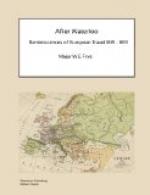Velletri is a large town or rather city situated on a mountain, to which you ascend by a winding road skirting a beautiful forest. From the terrace of one of the Palazzi here, you have a superb view of all the plain below as far as the rock of Circe, comprehending the Pontine marshes. There are several very fine buildings at Velletri, and it is remarkable as being the birthplace of Augustus Caesar. There is a spacious Piazza too on which stands a bronze statue of Pope Urban VIII. Velletri is twenty-eight miles from Rome.
The next morning, the 27th, we started early so as to arrive by six o’clock in the evening at Terracina. At Cisterna is a post-house and at Torre tre Ponti is a convent, a beautiful building, but now delapidated and neglected. Near it is a wretched inn, where however you are always sure to find plenty of game to eat. Here begin the Pontine marshes and the famous Appian road which runs in a right line for twenty-five miles across the marshes. It was repaired and perfectly reconstructed by Pius VI, and from him it bears its present appellation of Linea Pia. This convent and church were also constructed by Pius VI with a view to facilitate the draining and cultivating of the marshes by affording shelter to the workmen. The Linea Pia is a very fine chaussee considerably raised above the level of the marsh, well paved, lined with trees and a canal sunk on one side to carry off the waters. The Pontine marshes extend all the way from Torre tre Ponti to Terracina. On the left hand side, on travelling from Rome to Naples, you have two miles or thereabouts of plain bounded by lofty mountains; on the right a vast marshy plain bounded by the sea at a distance of seven or eight miles. Nothing can be more monotonous than this strait road twenty-five miles in length, and the same landscape the whole way. The air is extremely damp, aguish and unhealthy. Those who travel late in the evening or early in the morning are recommended not to let down the glasses of the carriage, in order to avoid inhaling the pestilential miasma from the marshes, which even the canal has not been able to drain sufficiently.
No one can find amusement in this desolate region but the sportsman; and he may live in continual enjoyment, and slay wild ducks and snipes in abundance; a number of buffaloes are to be seen grazing on the marshes. They are not to be met with to the North of Rome. They resemble entirely the buffaloes of Egypt and India, being black, and they are very terrific looking animals to the northern traveller, who beholds them here for the first time.
These marshes supply Rome abundantly with waterfowl and other game of all kinds. Every vetturino who is returning to Rome, on passing by, buys a quantity, for a mere trifle, from the peasantry, who employ themselves much a la chasse, and he is certain to sell them again at Rome for three or four times the price he paid, and even then it appears marvellous cheap to an Englishman, accustomed as he is to pay a high price for game in his own country.




